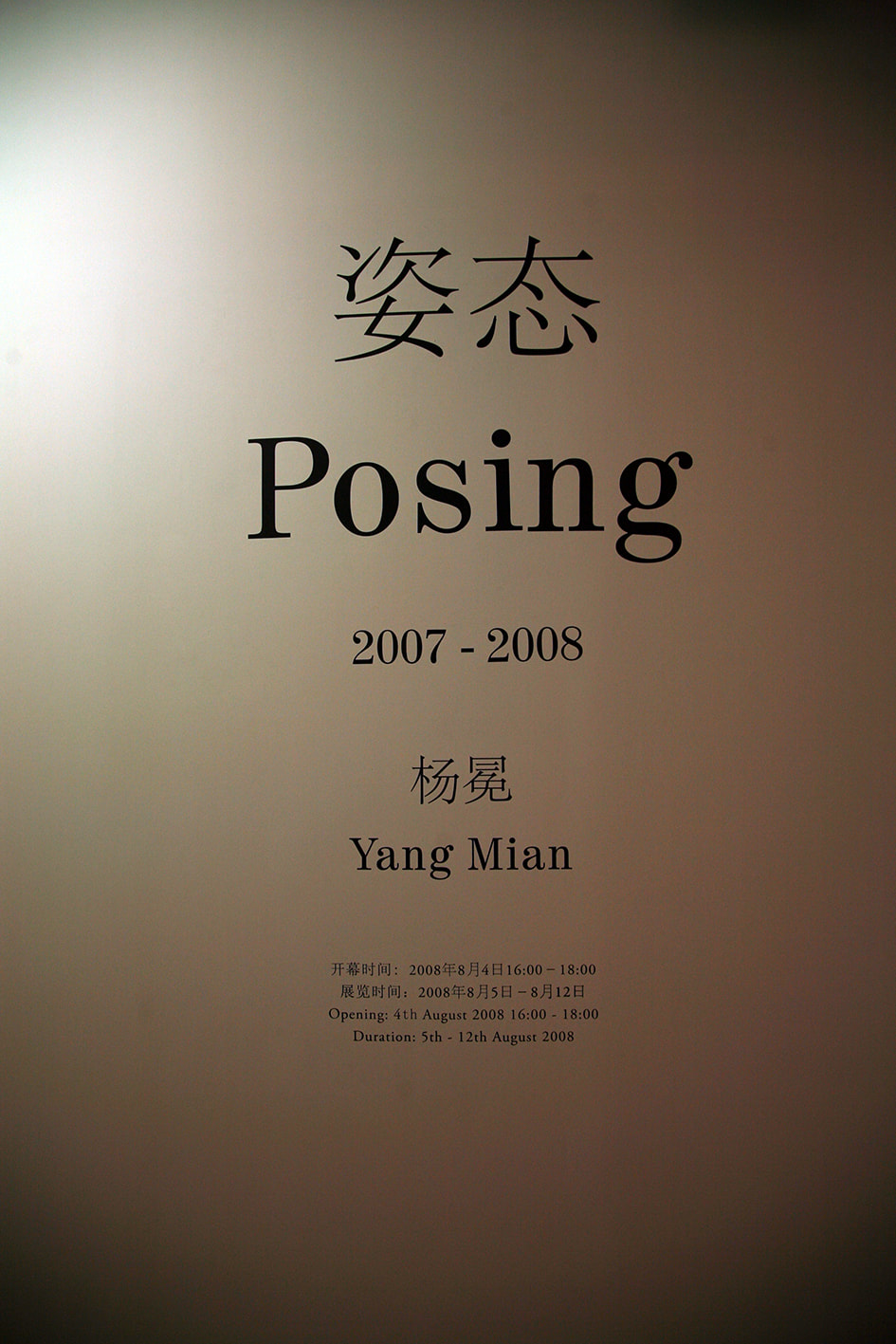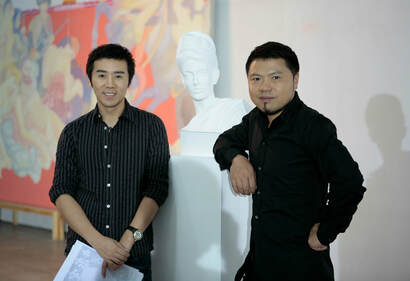|
从经典到标准
皮力 2007 杨冕早年的绘画是将日常广告中的图象用自己的方式刻画出来。所有的这些人物在他的画面中失去了原先的光泽,他们被画家用各种技巧虚化,弱化,沦为一个平面,或者说是一个不真实的存在。这些图象即使是真实的,也像是被蒙上了一层人工的迷雾。所有的这些无异于在向人们展示左右我们生活的各种“标准”虚幻的一面。在这里,微笑已经不复是一种表情,一种情绪的外化,相反它只是一个面具,一个现实和梦想之间距离的指示物。它越是灿烂就越意味着距离的遥远和标准的高不可攀。最后,所有画面的精华便落实在那道反复出现的色彩上。如果这一个个美妙的瞬间虚化处理还为观众们保留着撩开的面纱,接近美好的可能的话,那么这道色彩的出现则似乎预示着无可挽回的否定。我们甚至可以将它看作是一种故意的破坏,对于标准和现实生活之间距离的无情的肯定。 杨冕把这些作品的方法定义为“标准”。对于他来说“标准”意味着对于标准和现实的追问。如果说这些作品展示了弥漫在社会上的标准是什么的话,那么这些作品的潜台词是“谁是这些标准的制定者?”。从社会学的意义上说广告形象的出现本身或许不是为了确立某种标准,微笑本身的也不过是一种引诱而已。这些形象的个体存在尚可以让人们感觉到其肤浅,但是一旦它们超量的存在,肤浅就开始隐含在亲情之中,并深深的渗透在整个社会的潜意识之中。杨冕的作品正是以一种调侃的形式暗示出这种超量的存在和亲情的虚伪性。杨冕的作品正是在这个基点上获得了更深的意义空间,展示出新一代画家的个性化特征。 杨冕的绘画是一个奇怪的混合物,它是流行图象、社会评论和学院主义三者的结合。他的绘画并不是直接挪用大众的图象,而是用学院化的油画技法将这些图象雅化,从而实现一种图象上的转换。在这批商业文化抚育出来的一代画家身上,学院主义和流行文化的关系就象家庭文化和社会文化一样,后者往往还有着盛于前者的影响力。所以杨冕的进行转换造就了社会批判的双向性:对于学院主义的调侃和商业文化的质疑。 沿着这个思路,在最新展览的作品中,杨冕将自己的作品引向了另一个方向,既所谓的“经典”。杨冕所要谈论的经典不仅是古典意义上的经典,而且也包括了消费时尚的经典。在这个过程中,他延续了原先的图示修正的做法。一方面,他对自身的知识背景进行了清点,把艺术史上的经典画面进行时尚化的修正。他把画面中的人换成抽象而平面的人,同时通过鲜艳的颜色和平涂化处理,使那些古典主义的画面开始变的单薄而肤浅。另一方面,他对那些时尚摄影的图片进行处理,使之变成立体。在这些雕塑的作品中,我们还是能感觉到强烈的平面化的趣味。 和以往的作品相比,这些作品不再是对于时尚和流行的一种简单的态度和批判。艺术家将自己的目光转向了对于视觉文化的考察。无论是艺术史上的经典画面还是时尚画报上的经典摄影,他们都是影响我们今天视觉和行为的一部分。在这里,“经典”是“标准”的延伸,但是所关注的深度却加强了。杨冕将学院绘画中的视觉丰富性简单化,同时也将简单直接的时尚摄影变得更加富有视觉趣味。其核心是在探讨我们视觉观念的来源和组成。如果说标准系列关注的是当下,那么经典系列则关注的是过去和现在之间的连接。从这个意义上说,强烈的观念性是这些作品的显著特点。同时相比“标准”系列,“经典”系列在视觉的组合上更加复杂和令人玩味。 就像我一直所坚持表述的,杨冕的作品代表了一种对于当代社会中视觉文化的更深入也更理性的解读。他没有如政治波普一般将流行文化简单化、符号化,也没有如卡通艺术家那样,在研究流行文化的时候把自己变得比流行文化更加弱智。和艳俗艺术与政治波普相比,他对流行文化有着更深的了解,他不是将现成的图象作为一种手法,而是将它们作为自己工作的对象本身。这样他回避了某种危险,或者说是前几代中国画家的悲剧性命运:即为诸如西方的展览策划人、画廊老板一类的政治和艺术掮客所利用,将中国当代艺术中正常的,公正批判精神肆意曲解成针对某个非西方化意识形态的挑战,成为西方政治观念的注脚和文化侵略的借口。杨冕的作品展示的是一种双向性,他批判的是商业文化和视觉文化本身,他所研究的是观念,而转换的是视觉。问题其实往往就是这么简单。 Curator:Pili / 策展人:皮力 |
From Classic to Standard Pi Li
2007 Yang Mian’s early paintings depict the images from daily advertisements in his own way. Losing the previous shine, all the figures in his work are diminished and weakened into two-dimension in various skills by the artist, in another word, an unreal existence. Even these images are real, they still seem to hide behind a layer of artificial fog. All these undoubtedly reveal an illusionary aspect of different “standards” in our life. Here, smile is no longer an expression or emotional exteriorization, on the contrary, it’s just a mask, an indication of the distance between reality and dream. The more splendid it is, the more remote and unreachable the standard is. Eventually, all the essence of the paintings comes to the repeatedly emerging color line. If the delicate disposal of transient diminishment still keeps the raised veil for the audience to be close to beauty, the appearance of this color line seems to predict the irrevocable negation. We could even take it as an intentional damage, unmerciful affirmation of the distance between standard and real life. Yang defines the way of these works as “standard”. For him, “standard” means the incessant questioning of standard and reality. If these works present the standards pervading the society, the unspoken line is “who are the producer of these standards?” In the sense of sociology, the emergence of ad image is not to set up a certain standard, and smile itself is just a sort of temptation. The individual existence of these images may give the impression of superficialness, however, once they exist in overwhelming quantity, superficialness would be implied by blood complex, and deeply permeate the whole social sun-consciousness. Yang’s works hint the exceeding existence and blood complex’s hypocrisy in a teasing way. Based on this point, Yang’s works obtain more profound space of significance, presenting the individual features of artists of the new generation. As an odd combo, Yang’s painting is the integration of popular image, social critique and academicism. He refines these images in the skill of academic oil painting to realize a transformation in image instead of directly borrowing popular images. Among the artists of this generation cultivated in commercial culture, the relation between academicism and pop culture is like that between family culture and social culture, and the latter is usually more influential than the former. Therefore, Yang’s transformation leads to the two-way social critique, i.e. mockery of academicism and query of commercial culture. Along this thinking trend, among the newest exhibits, Yang leads his works to another direction, a.k.a. “classic”. Yang’s classic is not only classic of historical significance, but also contains the classic of consumption fashion. During the process, he continues the means of modifying previous images. On one hand, he sorts out his own background of knowledge, stylistically modifying the classic paintings in art history. He transforms the figures in works into abstract and two-dimensional ones, meanwhile turns the paintings of classicism into thinness and superficialness through bright colors and flat smearing. On the other hand, he processes the pictures of fashion photography, turning them into three-dimension. We could still strongly feel the two-dimensional interest from his sculptures. Compared with the previous works, these works are no long a simple attitude and critique about fashion and popularity. The artist turns his attention to visual art. No matter classic paintings in art history or classic photographs in fashion magazine, they are one part of the influence affecting out present vision and behavior. Here, “classic” is the extension of “standard”, yet the attention’s profundity has been strengthened. Yang simplifies the visual diversity in academic painting, meanwhile adds more visual pleasure into simple and straightforward fashion photograph. The core is to discuss the source and composition of our visual concept. If we say the series of “standard” emphasizes the present, the series of “classic” is concerned with the connection between the past and the present. In this sense, strong conceptuality is the conspicuous feature of these works. Meanwhile, compared with the series of “standard”, the series of “classic” is more complicated and meaningful in visual combination. Just like what I have been insisting, Yang’s works represent a more profound and rational interpretation of visual culture in contemporary society. Unlike political pop art, he doesn’t simplify and symbolize popular culture; unlike cartoon artists, he doesn’t put himself in the level lower than popular culture during research. Compared with gaudy art and political pop, he has deeper comprehension of popular culture. Instead of using existent images as a means, he regards them as the objects of his career. Therefore, he avoids a sort of danger, in another word, the tragic destiny of Chinese painters in the previous period, which means they were used by political and art agents such as western curators or gallery owners to twist normal and fair critical spirit in Chinese contemporary art into the annotation of western political concept and excuse of cultural invasion. Yang’s works reflect a two-way ideology, criticizing commercial culture and visual culture themselves, studying the concept and transforming vision. Actually, the problem is just so simple. |

